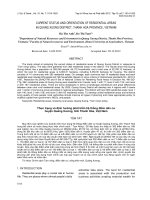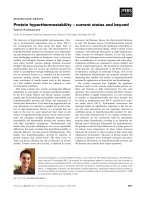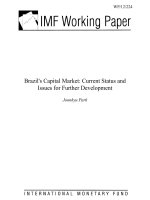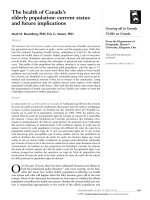Current status and policy recommendations to ensure social protection for Vietnamese families
Bạn đang xem bản rút gọn của tài liệu. Xem và tải ngay bản đầy đủ của tài liệu tại đây (183.26 KB, 11 trang )
Current Status and Policy Recommendations
to Ensure Social Protection for
Vietnamese Families
Dang Nguyen Anh1
1
Institute of Sociology, Vietnam Academy of Social Sciences.
Email:
Received on 8 August 2018.
Revised on 10 August 2018.
Accepted on 7 September 2018.
Abstract: Vietnam is making every effort to enhance the quality of people’s life and welfare. Over
the past 30 years of đổi mới, or renovation, process, the social protection system has been improved
gradually. There exist, however, many challenges and inadequacies in the social protection system.
The household-based access to social protection and gender mainstreaming remain limited,
especially in the areas of vocational training and elderly care. Those who have participated in social
insurance to receive retirement pensions in the future just make a low proportion. The quality of the
healthcare services covered by the health insurances is not good enough. People still consider
social protection to be a type of subsidy from the Government, which is not enthusiastic about
issuing social protection policies. This paper focuses on the current status of social protection
policies and suggests several possible policy responses, aiming at improving social protection for
the Vietnamese families.
Keywords: Social protection, social insurance, vocational training, social assistance, family
security policy, Vietnam.
Subject classification: Sociology
1. Introduction
Social protection is one of the important
components in the national development
strategies, which helps to stabilise the
socio-political situation, regulate the
stratification of living standards, narrow
the gap between rich and poor, and create
a consensus among different social groups.
Social protection not only refers to the
economic dimension but also has profound
significance in social and human aspects.
An effective system of social protection
will contribute an important part towards
the national governance as well as
community and family development.
Based on the social protection policies, the
State can redistribute incomes and social
3
Vietnam Social Sciences, No. 2 (190) - 2019
services to the most vulnerable groups
like low-income households, aiming at
reducing poverty, preventing the risk of
falling back into poverty, and gradually
tackling social inequality.
The Social Protection Floor has been
ratified by the United Nations, enabling all
people to have at least a guaranteed
minimum income (GMI) and access basic
social services, to ensure the basic rights,
promoting economic development, and
protecting the environment. It is aimed at
achieving the 17 Sustainable Development
Goals (SDGs) with the active participation
of the State institutions, private and
voluntary organisations, enterprises, and all
citizens [9]. In Vietnam, the issue of
ensuring social protection has always been
an important policy for national
sustainable development by the State and
the Party. Resolution No.15-NQ/TW (of
the 11th Central Committee of the
Communist Party of Vietnam) dated 1 June
2012, focusing on several social policy
issues during the 2012-2020 period, is a
sound decision about improving social
protection for all citizens, especially the
poor, people who are in especially difficult
situations, and people of ethnic minorities.
In Decision No.622/QĐ-TTg promulgated
in 2017 on a national action plan for the
implementation of the 2030 Agenda for
Sustainable Development, remarkably, the
Prime Minister emphasises the importance
of paying particular attention to and
providing support for those, who are in
difficult circumstances, such as the elderly,
the poor, people with disabilities, ethnic
minorities in remote areas, women, children,
and other vulnerable people so that “no one
is left behind” [8].
4
Despite different understandings of social
protection in Vietnam, there is a general
consensus that a social protection system is
considered successful, only when it shows
capable measures to shelter individuals and
social groups from risks and damage caused
by natural calamities as well as negative
socio-economic impacts so that their
standards of living and essential needs for a
means of living can be maintained. An
advanced social protection system should be
examined on the basis of the risk
management model with three strategies,
including risk prevention, risk mitigation, and
risk overcoming [5]. Over several periods, the
social protection system in Vietnam has been
increasingly improved, consisting of the
following groups of policies [7]:
- Policies on social insurances: Designed
to provide support for those, who have taken
part in the insurance system, so that they
can minimise risks due to sickness, pregnancy,
employment injury, unemployment, or old
age, based on compensation for the amount
of income they have lost due to the risks
mentioned above;
- Policies on social assistance: Designed
to provide regular or unscheduled (irregular)
support for reducing and overcoming risks
caused by a bad harvest, natural calamities,
accidents, or conflicts etc.;
- Policy on employment creation:
Designed to ensure a minimum income and
poverty reduction, enabling people to be
proactive in preventing risks when taking
part in the labour markets so that they can
get a good job and the minimum income to
cover basic needs.
In addition to the social protection
policies, the State has also promulgated a
Dang Nguyen Anh
number of social policies to strengthen the
people’s access to basic services (to a
certain extent) such as education,
healthcare, housing, farmland, clean water,
information and communication. Those
social services are closely related to the
sustainable development goals, playing a
significant role in eradicating poverty in all
its forms. At the same time, those policies
have overall social significance, ensuring
that everyone can take part in and benefit
from achievements of the economic growth.
This paper is a result of the research
project titled “Social Protection Policies for
Vietnamese Families in the Context of
Modernisation and International Integration”
coded KHXH-GD/16-19/06, a component of
the Ministerial Science and Technology Focal
Research Programme conducted by the
Vietnam Academy of Social Sciences
(VASS) with the aim of providing
comprehensive assessments of Vietnamese
families in the period of industrialisation,
modernisation, and international integration.
Besides analysing available data on social
protection as well as findings of various
research works, the author focused on the
directions and policies on social insurance,
employment, vocational training, and social
assistance to point out the current status of
social protection for the Vietnamese families.
The paper, therefore, reviews and analyses
the existing social protection policies, based
on which several policy recommendations are
proposed to enhance social protection for
families and family members in Vietnam.
The following part describes the familyrelated social protection policies, which are
being implemented at present. First of all, it is
the social insurance policy, a key component
of the social protection system.
2. Existing policies on social protection
for the Vietnamese families
During the transition from the model of
social welfare based on the centrally
planned subsidised economy to the model
of social welfare corresponding to the
socialist-oriented market economy in
Vietnam, social protection was not fully
improved to meet practical demands in
society. This reflects the modest coverage
of social insurance and unemployment
insurance; benefits were low; access to
social protection was limited and
unreachable by some social groups; and,
resources mobilised for the implementation
of the social protection policies were small,
mainly relying on scanty funding from
public budget. Meanwhile, people did not
pay attention to self-improvement. The role
played by relevant institutions became more
and more ineffective in ensuring the
traditional social protection. Families,
villages, and communities were no longer
useful institutions to protect and care for
their members, leading to new challenges
and difficulties to the current social
protection policies.
2.1. Policies on social insurance and
healthcare insurance
Social insurance guarantees the replacement
or the compensation of an income that
labourers have lost due to sickness, pregnancy,
employment injury, unemployment, retirement,
or death, based on the contributions they
have made to the social insurance fund
sponsored by the State. At present, the
social insurance in Vietnam includes the
following types: (1) Mandatory insurance
5
Vietnam Social Sciences, No. 2 (190) - 2019
rendered to the situation of sickness,
pregnancy, employment injury, retirement,
and death; (2) Voluntary social insurance
rendered to the situation of retirement and
death; and, (3) Unemployment insurance
consists of unemployment benefits,
occupational training support, and jobseeking support.
According to a report of the Vietnam
Social Security (VSS), by the end of 2017,
the number of people participating in social
insurance remained small. It was 13.9
million, accounting for 29% of the total
number of people at the labour age in
Vietnam. Moreover, most of those labourers
took out mandatory social insurance (13.6
million), and very few took out voluntary
one (0.3 million) [4]. The proportion of
insurance participants has increased mainly
in the groups of people working for the
State. It means that common people are not
enthusiastic about the insurance programmes,
which still have many shortcomings and lack
necessary attractiveness. The number of
insurance participants applying for an onetime insurance payment has been increasing
rapidly, by roughly 700 thousand each year.
This means that they leave the insurance
system and will not receive a retirement
pension. Those are mainly the labourers
dismissed from enterprises, but they find it
difficult to get a new job in other enterprises
and to continue paying monthly premiums.
These people, consequently, decide to
receive an one-time insurance payment. In
addition, some enterprises have deliberately
delayed or avoided paying for their workers’
mandatory insurance, resulting in an
accumulated insurance debt of several
trillion VND. In the closing report of the 7th
plenary session of the 11th Central Committee
6
of the Communist Party of Vietnam,
mentioning the social insurance policy,
General Secretary Nguyen Phu Trong
emphasised the necessity of having
innovative measures to develop and expand
the people’s participation in social insurance,
as it remained lower than the potentiality [3,
p.4]. Social insurance policies enable
labourers, who do different jobs, work in
different economic sectors, and live in
different areas, to participate in the social
insurance programme. The funding of the
social insurance programme is mainly based
on financial contributions made by labourers
and their employers. It also receives some
financial support from the State budget and
runs under the supervision and sponsorship
of the Government.
Health insurance is an important part of
social insurance and a major component
of social protection [1]. Health insurance
is compulsory under the law, aimed at
providing health care and preventing and
sharing the risk when a person encounters
sickness or injury. The situation of the
health insurance system in Vietnam, however,
does not look more optimistic, although the
proportion of people participating in the
health insurance programme is relatively
high (nearly 81 million people, making up
86.4% of the whole population). The
reason is that most of the people, who have
health insurance, are those who get a
healthcare subsidy from the Government.
Noticeably, the quality of medical
examination and treatment provided
through the health insurance programme
has not satisfied the demand and expectation
of the people. The regulation on householdbased health insurance plans shows many
shortcomings, though the amended Law on
Dang Nguyen Anh
Health Insurance has been promulgated. At
first sight, the regulation on household-based
insurance plans seems to be reasonable, but
its implementation has caused many
difficulties for people in practice. The fact
that household members are recognised on
the basis of the household register of
permanent residence (Vietnamese: hộ khẩu).
It is quite inappropriate and does not show the
actual residence status. The law regulates that
a person can buy health insurance only when
he or she is named in a household register of
a permanent residence, it excludes those who
do not have a permanent residence and those
who are not named in the household register
of any permanent residence. Thus, the
household-based health insurance, attached
too closely with the register of permanent
residence, has resulted in difficulties for the
labourers working at enterprises. Those
labourers are not provided with new health
insurance numbers (i.e. they are not allowed
to buy new health insurance plans), because
they were provided with health insurance
numbers at the households in the local areas,
where they have their permanent residence.
The people’s trust in the quality of health
insurance is fading gradually, leading to an
erroneous consciousness of social protection.
Obviously the existing health insurance
policy does not demonstrate the risk-sharing
among all participants. The quality of the
medical examination and treatment service,
of which expenses are covered by health
insurance, is not reliable enough to persuade
people to use the services, resulting in a waste
of resources and making the health insurance
programme ineffective.
Due to the limited management facilities
and qualifications as well as the
shortcomings of the current policies, social
insurance and health insurance, representing
the most important components of social
protection, have not met the demands of the
society. Herein, the question is how social
insurance and health insurance policies
should be designed in order to be effective
and appropriate to meet the sustainable
development goals until 2030.
2.2. Labour market policies
Within the framework of social protection,
the labour market policies include: policy
on labour market development; policy on
preferential loans for development of trade,
production and job creation; policy on
vocational training support; and, policy on
sending labourers abroad under contract
(commonly called the labour export policy).
One of the objectives of those policies is to
provide support for labourers so that they
have more opportunities to get jobs, take
part in the labour market, and earn at least a
minimum income. Beneficiaries of those
policies include young workers, who start
to take part in the labour market; the
unemployed; and, those who are in need of
getting better jobs.
Trained female labourers or female
workers, who have had vocational training,
just make up a small proportion of all
female labourers in Vietnam. Meanwhile,
the proportion of untrained female
labourers amounted for 81.6% in 2016,
higher than the corresponding figure of
male labourers (76.7%). This figure is
directly proportional to age, reaching 92.3%
in the age group of 55 to 59 [6]. It
demonstrates that female workers have
much fewer opportunities to take part in the
skilled labour market, get a stable job, or earn
7
Vietnam Social Sciences, No. 2 (190) - 2019
a proper income. However, the proportion of
underemployed female workers2 is lower
than that of male ones in both urban and
rural areas. The reason is that female
workers are often ready to accept several
jobs simultaneously to get more earnings.
Furthermore, female workers are less
selective about jobs than male counterparts.
They agree to take a low-paid job offered to
them, in order to earn extra income;
whereas, male labourers rarely accept such
jobs [7]. In reality, the policies on providing
support for participation in the labour
market have not been considerably
improved. They have not met practical
demands, especially those of female
labourers and therefore have made gender
inequalities severer. As a result, a part of
female labourers, especially those who are
poor, have low levels of education, have not
experienced vocational training, or live in
rural areas, find it most difficult to access
and benefit from the policies.
2.3. Policies on vocational training and
support provision for post-training job seekers
Since the Law on Vocational Training came
into effect in 2006, many important policies
related to vocational training and support
provision for post-training job seekers have
been promulgated, aimed at concretising the
Law on Vocational Training in practice and
enhancing human resources. Instead of
providing direct support for households as a
whole, the policies address the provision of
vocational training for individuals, who are
household members such as female, young,
and male members. Some policies give
priority to only female workers. Especially,
there was a project (Project No. 205)
8
focused on helping women to learn working
skills and creating jobs during the period
from 2011 to 2015. Like the labour market
policies, however, the policies on
vocational training have not been conflated
fully and effectively with gender equality.
Female labourers are not provided with
favourable conditions by the policies. Most
of them, particularly rural women, ethnic
minority women, and women aged 35 or
over, do not have an opportunity to take
part in long-term regular courses or benefit
from the vocational training policies and
programs [7]. A large number of programmes
and projects within the social protection
framework provided only short-term
vocational training courses (less than three
months). In some areas, they were even
carried out in the form of peripatetic
training. Those types of training just
focused on some jobs, which did not require
the skills in using machines or equipment;
for example, seamstressing, embroidering,
weaving, cooking, beauty caring, farming,
and animal breeding. As the courses were
held for a short duration with very little
practice and the trainees could not get jobs
to do after the courses, the vocational
training was not as effective as expected.
From the perspective of social protection,
the regulations on the enrolment in longterm vocational training courses are seen as
an obstacle to those who want to take the
vocational training. Some policies and
mechanisms related to the provision of
support for vocational trainees are no longer
appropriate. They are not successful in
encouraging women, particularly rural
women, ethnic minority women and those
in remote areas, to take vocational training.
Specifically, the support for accommodation
Dang Nguyen Anh
expenses during the training periods is too
little to attract people to vocational training
programs. The policies on preferential loans
sometimes overlap each other and are not
implemented in combination with other
policies, such as the policy on providing
support for vocational training and the
policy on providing support for production
and consumption. The regulations on the
maximum amount, the duration, and the
conditions of loans are not appropriate to
the requirements of production and trade as
well as local and occupational characteristics.
In addition, the activities of disseminating
information and giving advice on vocational
training have not been developed at the grassroots level (in villages/communes). Those
who undertake the disseminating and
advising activities are not qualified enough
for the jobs, especially in rural, remote, and
ethnic minority areas. It is easy to realise
the shortage of policies encouraging
enterprises to provide vocational training or
set up production groups at the local areas,
aimed at helping labourers save money
from travelling and have a job to do after
the training.
2.4. Policies on social assistance
Social assistance policies are often
implemented regularly or irregularly, from
which elderly people benefit the most at
present. The old-age allowance is given on
a monthly basis to the elderly in poor
households, who are neither cared for nor
supported by anyone. It is also given to the
elderly aged 80 or above, who have neither
a monthly retirement pension nor social
insurance. In reality, however, the rural
elderly find it difficult to benefit from the
healthcare service, although they make up
the majority. In many local areas, a large
number of elderly people are living lonely
without being cared by others, since their
children have left the home village for a
faraway place to work or get married and
settle down. Due to a growing tendency of
young people to migrate to urban or
industrial areas, it is more difficult to care
for the elderly left behind. Meanwhile, there
are still many inadequacies in caring for the
elderly. The awareness of the population
ageing and its impacts on socio-economic
development remains limited. Local
authorities have not paid proper attention to
the population ageing. The elderly
themselves have not realised the need for
being cared for and protected; even, some
of them have not made any necessary
preparations for old age at all. The spiritual
life of the elderly mainly relies on some
social associations (such as the Association
of the Elderly and the Association of Life
Protection), which have very few activities
and a very limited fund [2, pp.4-12].
Population ageing has not been
concerned appropriately in the social
consciousness of the local governments at
different levels, though it is an obvious
trend at present. As the population is
ageing, many difficulties and challenges
arise, resulting in great pressure on the
systems of healthcare, social insurance,
retirement pensions, and other social
services. The population ageing started to
accelerate in the first decade of the 21st
century with the highest growth rate of the
elderly. Vietnam is, therefore, encountering
9
Vietnam Social Sciences, No. 2 (190) - 2019
three big problems related to the population
ageing and a growing quantity as well as a
growing proportion of the elderly. The
number of elderly people has been
increasingly rising. A large number of the
elderly are living below or marginally
above the poverty line. Most of the elderly
have poor health. The number of the
elderly living lonely is rising, as the
support from family members and relatives
is being narrowed. A majority of the
elderly are living and doing farming in rural
areas. As shown in reality, very few
elderly living in the countryside have a
retirement pension or receive a regular
allowance; they still have to work to earn a
living or rely on support from other family
members. The elderly, who are still
working to earn a living mainly in
agriculture, account for roughly 40% of all
the elderly in Vietnam. The total number of
the elderly, who have voluntary health
insurance, is just 1.1 million, making up
15% [11]. The elderly, who are living in
rural, remote, mountainous, border or island
areas, comprise a large proportion of all the
elderly, but they can hardly get access to
healthcare services and policies.
It is necessary to have a system of social
protection policies, which are more
appropriate to the demands and characteristics
of the population-ageing society in the
context of the market economy in Vietnam
and international changes. Social protection
services, particularly the systems of
retirement pensions, insurances, and elderly
care, require considerable resources and
long-term visions. Social protection for the
elderly must be considered in the context of
the family relationship and the material and
spiritual care from their family members.
10
3. Several recommendations and conclusions
Under the impacts of industrialisation,
migration, and international integration in
addition to a low birth rate and a fast
population ageing, the Vietnamese families
are not only getting increasingly smaller in
size but the family relations, specifically
the relations between different generations
and members, are becoming looser and
looser. The family cohesion is no longer as
tight as before [1, pp.4-12]. The impressive
economic growth during the entire past
decade is considered an opportunity to
improve the welfare of Vietnamese
families. There is, however, a big gap in the
access to resources between different
groups of people, particularly between the
rich and the poor. Especially, gender
inequality remains serious. The existing
social protection policies are not adequate
to meet the demands of families and build
trust among people. The transparency and
effectiveness are vague. It is quite common
that policies are implemented like
subsidisations. As a result, many people
receive support from the Government as a
subsidy, which does not match their
demands or expectations [12].
Drastic socio-economic changes and
macro-instabilities have caused severe
impacts on the performance of social
protection as well as the employment and
living conditions of people. The services of
job creation and vocational training have
not yet met the people’s demands. They
have not focused on improving the social
protection of families by providing support
to access the labour market. Especially,
gender equality has not been ensured. The
number of university graduates who cannot
Dang Nguyen Anh
get a job has amounted to hundred
thousand. Regarding the vocational training
programmes for rural areas, the trainees
cannot get an appropriate job to increase
their income as expected. Most of them
have no choice but return to agricultural
work that they used to do before taking part
in the vocational training [12].
The Party and the State have promulgated
sound guidelines and policies on social
protection. These policies, however, have not
been implemented effectively in practice.
The apparatus and financial resources for the
implementation of the policies were not built
transparently and appropriately. It was
sometimes carried out as a campaign, making
the effectiveness of the policies limited.
Although the social protection system has
step by step been developed in terms of
coverage, beneficiaries, and amounts of
benefit, the social protection policies for
Vietnamese families have not yet met the
requirements of sustainability and demands
of the people. Except for a small number of
preferential policies, such as the policies for
those families credited with contributions to
the revolution, the policies on provision of
healthcare support for poor households and
ethnic minority households, the existing
social protection policies mainly focus on
providing support for specific groups of
people, including the elderly, women,
children, and the disabled. Gender
mainstreaming has not been implemented
properly in social protection policies. Women
and girls remain disadvantaged in families,
particularly in poor and ethnic minority
families [11]. The growth in the quantity and
proportion of the elderly requires appropriate
social protection policies in order to cope
with today’s demographic changes [10].
Interventions in social protection
policies should concentrate on minimising
the vulnerability of families, managing
risks, and improving the protection of
family members before instabilities in life.
It is quite popular that people “manage
social protection separately on their own”,
which cannot ensure sustainability since
families are facing many more risks and
greater vulnerability at present. Besides, the
activities that provide support for the
elderly, lonely old people, poor households,
households credited with contributions to
the revolution, ethnic minority households,
and the disabled, etc. are seen by the people
as a subsidy from the Government, instead
of realising them as part of the social
protection programmes. It is, therefore,
necessary to take into account the following
recommendations:
Firstly, the regulation on buying health
insurance on the basis of the household
register of permanent residence should be
eliminated, as it causes obstacles to the
participation in health insurance, especially
for low-income households. The coverage
of social insurance remains limited and
does not seem to be improved soon. Getting
access to high-quality healthcare services
via health insurance is difficult. Thus, it is
essential to set up a mechanism for
effective coordination between different
types of insurances, aimed at providing
comprehensive insurance services to people.
Secondly, it is necessary to strengthen
propaganda to enhance the people’s awareness
of social protection and relevant policies.
Family members should be supported to
understand the social protection programmes
correctly so that they no longer realise social
protection as a subsidy from the Government.
11
Vietnam Social Sciences, No. 2 (190) - 2019
Social protection policies should consider the
context of market economic development, the
gap between the rich and the poor, and the
international changes that are hardly
predictable. Social protection is a pillar for
sustainable development and the basis for
performing and obtaining sustainable
development goals, as the commitments of the
Vietnamese Government with the international
community [9].
Thirdly, it is necessary to develop advisory
services related to vocational training and
employment promotion, providing free of
charge services for poor, ethnic minority,
low-educated, and migrant women. A
mechanism for close coordination between
organisations, agencies related to vocational
training at the central and local levels
(including the State labour management
agencies, local governments, vocational
training establishments, enterprises, and
socio-political organisations) must be set up.
Specific services, such as vocational training,
employment promotion, labour export and so
on should be addressed to families as the
main participant and beneficiary.
Fourthly, support and care for the elderly
should be considered as one of the
important components in social protection
policy-making. In reality, the population
trend continues to cause more challenges
and greater pressure on the systems of
healthcare, social insurance, retirement
pensions, and elderly care in Vietnam.
Consequently, social protection policies
should be more appropriate to Vietnamese
families as well as the demands and
characteristics of the ageing population. For
the elderly, social protection policies should
focus directly on the development
requirements of families, due to the role and
12
close relations of the family members with
the elderly. This is an effective measure to
cope with the population ageing which is
taking place rapidly in Vietnam at present.
Notes
1
The paper was published in Vietnamese in: Xã hội
học, số 2, 2018. Translated by Nguyen Tuan Sinh,
edited by Etienne Mahler.
2
The underemployed consist of those who work less
than 35 hours a week and expect to have extra work
to do.
References
[1] Đặng Nguyên Anh (2015), “An sinh xã hội ở
Việt Nam sau 30 năm Đổi mới và định hướng
đến 2030”, Tạp chí Xã hội học, số 2 (130).
[Dang Nguyen Anh (2015), “Social Protection
in Vietnam over 30 Years of Renovation and
Orientation
towards
2030”,
Journal
of
Sociology, No. 2 (130)].
[2] Đặng Nguyên Anh và Trịnh Duy Luân (2014),
Báo cáo rà soát pháp luật, chính sách trợ giúp
xã hội cho người cao tuổi ở Việt Nam, Cục Bảo
trợ xã hội và Quỹ Dân số Liên Hợp Quốc, Hà
Nội. [Dang Nguyen Anh and Trinh Duy Luan
(2014), Evaluating Report on Legal Regulations
and Policies Providing Social Assistance for the
Elderly in Vietnam, Department of Social
Assistance and the United Nations Population
Fund (UNFPA), Hanoi].
[3] Báo Nhân dân (2018), Hướng tới bảo hiểm xã
hội toàn dân, ngày 11 tháng 6 năm 2018, Hà
Nội. [Nhan Dan (People) Newspaper (2018),
Towards Social Insurance for the Whole
Population, 11 June 2018, Hanoi].
Dang Nguyen Anh
[4] Bảo hiểm xã hội Việt Nam (2018), Báo cáo
ngày
Tổng kết năm 2017 của Bảo hiểm xã hội Việt
22 tháng 5 năm 2018. [Prime Minister
Nam, Hà Nội. [Vietnam Social Security (2018),
(2017), Decision No.662/TTg dated 10 May
2017 Annual Report of Vietnam Social
2017 on Promulgation of National Action
Security, Hanoi].
Plan
Mai Ngọc Cường (2009), Xây dựng và hoàn
Development,
thiện hệ thống chính sách an sinh xã hội ở Việt
ban.aspx, retrieved on 22 May 2018].
[5]
for
2030
Agenda
on
Sustainable
/>
Nam, Nxb Chính trị quốc gia, Hà Nội. [Mai
[9] UNDP (2015), Các mục tiêu phát triển bền
Ngoc Cuong (2009), Building and Completing
vững SDGs, New York. [UNDP (2015),
System of Social Protection Policies in Vietnam,
Sustainable Development Goals, New York].
National Political Publishing House, Hanoi].
[10] UNFPA (2011), Già hóa dân số và người cao
[6] Trần Quý Long (2018), “Đặc điểm và một số
tuổi ở Việt Nam: Thực trạng, dự báo và một số
chiều cạnh thực trạng lao động nữ không qua
khuyến nghị chính sách, Hà Nội. [UNFPA
đào tạo”, Kỷ yếu Hội thảo khoa học Lao động
(2011), Ageing Population and Elderly in
nữ chưa qua đào tạo những vấn đề xã hội
Vietnam: Current Status, Prognosis, and
trong kỷ nguyên số, Hội Liên hiệp Phụ nữ Việt
Policy Recommendations, Hanoi].
Nam và Viện Hàn lâm Khoa học xã hội Việt
[11] Viện Khoa học Lao động và Xã hội (2015),
Nam, Nxb Lao động, Hà Nội. [Tran Quy Long
Báo cáo An sinh xã hội đối với phụ nữ và trẻ
(2018), “Characteristics and Some Aspects of
em gái Việt Nam, Bộ Lao động - Thương binh
Situation of Untrained
Labourers”,
và Xã hội, Hà Nội. [Institute of Labour Science
Proceedings of Conference “Untrained Female
and Social Affairs (2015), Report on Social
Labourers: Social Issues in Digital Era”, Vietnam
Protection for Women and Girls in Vietnam,
Women’s Union and Vietnam Academy of Social
Ministry of Labour, Invalids and Social
Sciences, Labour Publishing House, Hanoi].
Affairs, Hanoi].
Female
[7] Mạc Văn Tiến (2005), An sinh xã hội và phát
[12] Viện Xã hội học (2018), Báo cáo tổng hợp Đề
triển nguồn nhân lực, Nxb Lao động - Xã hội, Hà
tài: "Chính sách an sinh xã hội cho các gia
Nội. [Mac Van Tien (2005), Social Protection
đình ở Việt Nam trong bối cảnh hiện đại hóa
and Human Resource Development, Labour
và hội nhập quốc tế", Mã số KHXH-GĐ/16-
and Social Affairs Publishing House, Hanoi].
19/06, Hà Nội. [Institute of Sociology (2018),
[8] Thủ tướng Chính phủ (2017), Quyết định
Final Report of the Project on Social Protection
662/TTg ngày 10/5/2017 về việc ban hành Kế
Policies for Families in Vietnam in the Context of
hoạch hành động quốc gia thực hiện Chương
Modernisation and International Integration,
trình Nghị sự 2030 vì sự phát triển bền vững,
Coded KHXH-GĐ/16-19/06, Hanoi].
13









